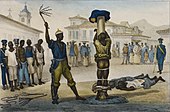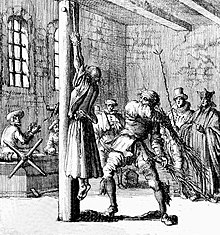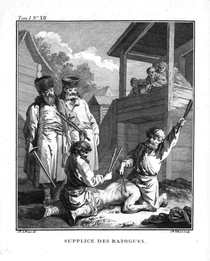
A | B | C | D | E | F | G | H | CH | I | J | K | L | M | N | O | P | Q | R | S | T | U | V | W | X | Y | Z | 0 | 1 | 2 | 3 | 4 | 5 | 6 | 7 | 8 | 9
| Part of a series on |
| Corporal punishment |
|---|
 |
| By place |
| By implementation |
| By country |
| Court cases |
| Politics |
| Campaigns against corporal punishment |
A corporal punishment or a physical punishment is a punishment which is intended to cause physical pain to a person. When it is inflicted on minors, especially in home and school settings, its methods may include spanking or paddling. When it is inflicted on adults, it may be inflicted on prisoners and slaves, and can involve methods such as whipping with a belt or a horsewhip.
Physical punishments for crimes or injuries, including floggings, brandings and even mutilations, were practised in most civilizations since ancient times. With the growth of humanitarian ideals since the Enlightenment, such punishments are increasingly viewed as inhumane in Western society. By the late 20th century, corporal punishment had been eliminated from the legal systems of most developed countries.[1]
In the twenty-first century, the legality of corporal punishment in various settings differs by jurisdiction. Internationally, the late twentieth and early twenty-first centuries saw the application of human rights law to the question of corporal punishment in a number of contexts:
- Corporal punishment in the home, the punishment of children by parents or other adult guardians, is legal in most of the world. As of 2023, 65 countries, mostly in Europe and Latin America, have banned the practice.[2]
- School corporal punishment, of students by teachers or school administrators, such as caning or paddling, has been banned in many countries, including Canada, Kenya, South Africa, New Zealand and all of Europe. It remains legal, if increasingly less common, in some states of the United States and in some countries in Africa and Southeast Asia.
- Judicial corporal punishment, such as whipping or caning, as part of a criminal sentence ordered by a court of law, has long disappeared from most European countries.[3] As of 2021, it remains lawful in parts of Africa, Asia, the Anglophone Caribbean and indigenous communitiesn in several countries of South America.[3]
- Prison corporal punishment or disciplinary corporal punishment, ordered by prison authorities or carried out directly by correctional officers against the inmates for misconduct in custody, has long been common practice in penal institutions worldwide. It has officially been banned in most Western civilizations during the 20th century, but is still employed in many other countries today. Punishments such as paddling, foot whipping or different forms of flagellation have been commonplace methods of corporal punishment within prisons. This was also common practice in the Australian penal colonies and prison camps of the Nazi regime in Germany.
- Military corporal punishment is or was allowed in some settings in a few jurisdictions.
In many Western countries, medical and human rights organizations oppose the corporal punishment of children. Campaigns against corporal punishment have aimed to bring about legal reforms in order to ban the use of corporal punishment against minors in homes and schools.
History
Prehistory
Author Jared Diamond writes that hunter-gatherer societies have tended to use little corporal punishment whereas agricultural and industrial societies tend to use progressively more of it. Diamond suggests this may be because hunter-gatherers tend to have few valuable physical possessions, and misbehavior of the child would not cause harm to others' property.[4]
Researchers who have lived among the Parakanã and Ju/'hoansi people, as well as some Aboriginal Australians, have written about the absence of the physical punishment of children in those cultures.[5]
Wilson writes:
Probably the only generalization that can be made about the use of physical punishment among primitive tribes is that there was no common procedure Pettit concludes that among primitive societies corporal punishment is rare, not because of the innate kindliness of these people but because it is contrary to developing the type of individual personality they set up as their ideal An important point to be made here is that we cannot state that physical punishment as a motivational or corrective device is 'innate' to man.[6]
Antiquity


In the Western world, the corporal punishment of children has traditionally been used by adults in authority roles.[7] Beating one's son as a form of punishment is even recommended in the book of Proverbs:
He that spareth the rod, hateth his son; but he that loveth him, chasteneth him betimes. (Proverbs 13:24)
A fool's lips enter into contention, and his mouth calleth for strokes. (Proverbs 18:6)
Chasten thy son while there is hope, and let not thy soul spare for his crying. (Proverbs 19:18)
Foolishness is bound in the heart of a child; but the rod of correction shall drive it from him. (Proverbs 22:15)
Withhold not correction from the child; for if thou beatest him with a rod, thou shalt deliver his soul from hell. (Proverbs 23:13–14)[8]
(Note: it has been debated among scholars as to whether what is encouraged here is the corporeal punishment of a "child" or a "young man". The word translated "child" in most cases in the Bible refers to a young man rather than a child.)[9]
Robert McCole Wilson argues that, "Probably this attitude comes, at least in part, from the desire in the patriarchal society for the elder to maintain his authority, where that authority was the main agent for social stability. But these are the words that not only justified the use of physical punishment on children for over a thousand years in Christian communities, but ordered it to be used. The words were accepted with but few exceptions; it is only in the last two hundred years that there has been a growing body of opinion that differed. Curiously, the gentleness of Christ towards children (Mark, X) was usually ignored".[10]

Corporal punishment was practiced in Egypt, China, Greece, and Rome in order to maintain judicial and educational discipline.[11] Disfigured Egyptian criminals were exiled to Tjaru and Rhinocorura on the Sinai border, a region whose name meant "cut-off noses." Corporal punishment was prescribed in ancient Israel, but it was limited to 40 lashes.[12] In China, some criminals were also disfigured but other criminals were tattooed. Some states gained a reputation for their cruel use of such punishments; Sparta, in particular, used them as part of a disciplinary regime which was designed to increase willpower and physical strength.[13] Although the Spartan example was extreme, corporal punishment was possibly the most frequent type of punishment. In the Roman Empire, the maximum penalty which a Roman citizen could receive under the law was 40 "lashes" or 40 "strokes" with a whip which was applied to the back and shoulders, or 40 lashes or strokes with the "fasces" (similar to a birch rod, but consisting of 8–10 lengths of willow rather than birch) which were applied to the buttocks. Such punishments could draw blood, and they were frequently inflicted in public.
Quintilian (c. 35 – c. 100) voiced some opposition to the use of corporal punishment. According to Wilson, "probably no more lucid indictment of it has been made in the succeeding two thousand years".[13]
By that boys should suffer corporal punishment, though it is received by custom, and Chrysippus makes no objection to it, I by no means approve; first, because it is a disgrace, and a punishment fit for slaves, and in reality (as will be evident if you imagine the age change) an affront; secondly, because, if a boy's disposition be so abject as not to be amended by reproof, he will be hardened, like the worst of slaves, even to stripes; and lastly, because, if one who regularly exacts his tasks be with him, there will not be the need of any chastisement (Quintilian, Institutes of Oratory, 1856 edition, I, III).[13]
Plutarch, also in the first century, writes:
This also I assert, that children ought to be led to honourable practices by means of encouragement and reasoning, and most certainly not by blows or ill-treatment, for it surely is agreed that these are fitting rather for slaves than for the free-born; for so they grow numb and shudder at their tasks, partly from the pain of the blows, partly from the degradation.[14]

Middle Ages
In Medieval Europe, the Byzantine Empire blinded and denosed some criminals and rival emperors. Their belief that the emperor should be physically ideal meant that such disfigurement notionally disqualified the recipient from office. (The second reign of Justinian the Slit-nosed was the notable exception.) Elsewhere, corporal punishment was encouraged by the attitudes of the Catholic church towards the human body, flagellation being a common means of self-discipline. This had an influence on the use of corporal punishment in schools, as educational establishments were closely attached to the church during this period. Nevertheless, corporal punishment was not used uncritically; as early as the 11th century Saint Anselm, Archbishop of Canterbury was speaking out against what he saw as the excessive use of corporal punishment in the treatment of children.[15]
Modernity
From the 16th century onwards, new trends were seen in corporal punishment. Judicial punishments were increasingly turned into public spectacles, with public beatings of criminals intended as a deterrent to other would-be offenders. Meanwhile, early writers on education, such as Roger Ascham, complained of the arbitrary manner in which children were punished.[16]
Peter Newell writes that perhaps the most influential writer on the subject was the English philosopher John Locke, whose Some Thoughts Concerning Education explicitly criticised the central role of corporal punishment in education. Locke's work was highly influential, and may have helped influence Polish legislators to ban corporal punishment from Poland's schools in 1783, the first country in the world to do so.[17]



A consequence of this mode of thinking was a reduction in the use of corporal punishment in the 19th century in Europe and North America. In some countries this was encouraged by scandals involving individuals seriously hurt during acts of corporal punishment. For instance, in Britain, popular opposition to punishment was encouraged by two significant cases, the death of Private Frederick John White, who died after a military flogging in 1846,[18] and the death of Reginald Cancellor, killed by his schoolmaster in 1860.[19] Events such as these mobilised public opinion and, by the late nineteenth century, the extent of corporal punishment's use in state schools was unpopular with many parents in England.[20] Authorities in Britain and some other countries introduced more detailed rules for the infliction of corporal punishment in government institutions such as schools, prisons and reformatories. By the First World War, parents' complaints about disciplinary excesses in England had died down, and corporal punishment was established as an expected form of school discipline.[20]
In the 1870s, courts in the United States overruled the common-law principle that a husband had the right to "physically chastise an errant wife".[21] In the UK, the traditional right of a husband to inflict moderate corporal punishment on his wife in order to keep her "within the bounds of duty" was similarly removed in 1891.[22][23] See Domestic violence for more information.
In the United Kingdom, the use of judicial corporal punishment declined during the first half of the twentieth century and it was abolished altogether in the Criminal Justice Act, 1948 (zi & z2 GEo. 6. CH. 58.), whereby whipping and flogging were outlawed except for use in very serious internal prison discipline cases,[24] while most other European countries had abolished it earlier. Meanwhile, in many schools, the use of the cane, paddle or tawse remained commonplace in the UK and the United States until the 1980s. In rural areas of the Southern United States, and in several other countries, it still is: see School corporal punishment.
International treaties
Human rights
Key developments related to corporal punishment occurred in the late 20th century. Years with particular significance to the prohibition of corporal punishment are emphasised.
- 1950: European Convention of Human Rights, Council of Europe.[25] Article 3 bans "inhuman or degrading treatment or punishment".
- 1978: European Court of Human Rights, overseeing its implementation, rules that judicial birching of a juvenile breaches Article 3.[26]
- 1985: Standard Minimum Rules for the Administration of Juvenile Justice, or Beijing Rules, United Nations (UN). Rule 17.3: "Juveniles shall not be subject to corporal punishment."
- 1990 Supplement: Rules for the Protection of Juveniles Deprived of their Liberty. Rule 67: "...all disciplinary measures constituting cruel, inhumane or degrading treatment shall be strictly prohibited, including corporal punishment..."
- 1990: Guidelines for the Prevention of Juvenile Delinquency, the Riyadh Guidelines, UN. Paragraph 21(h): education systems should avoid "harsh disciplinary measures, particularly corporal punishment."
- 1966: International Covenant on Civil and Political Rights, UN, with currently 167 parties, 74 signatories.[27] Article 7: "No one shall be subjected to torture or to cruel, inhuman or degrading treatment or punishment..."
- 1992: Human Rights Committee, overseeing its implementation, comments: "the prohibition must extend to corporal punishment . . . in this regard . . . article 7 protects, in particular, children, . . .."[28]
- 1984: Convention against Torture and Other Cruel, Inhuman or Degrading Treatment or Punishment, UN, with currently 150 parties and 78 signatories.[29]
- 1996: Committee Against Torture, overseeing its implementation, condemns corporal punishment.[30]
- 1966: International Covenant on Economic, Social and Cultural Rights, UN, with currently 160 parties, and 70 signatories.[31] Article 13(1): "education shall be directed to the full development of the human personality and the sense of its dignity..."
- 1999: Committee on Economic, Social and Cultural Rights, overseeing its implementation, comments: "corporal punishment is inconsistent with the fundamental guiding principle of international human rights law . . . the dignity of the individual."[32]
- 1961: European Social Charter, Council of Europe.
- 2001: European Committee of Social Rights, overseeing its implementation, concludes: it is not "acceptable that a society which prohibits any form of physical violence between adults would accept that adults subject children to physical violence."[33]
Children's rights
| Youth rights |
|---|
The notion of children's rights in the Western world developed in the 20th century, but the issue of corporal punishment was not addressed generally before mid-century. Years with particular significance to the prohibition of corporal punishment of children are emphasised.
- 1923: Children's Rights Proclamation by Save the Children founder. (5 articles).
- 1924 Adopted as the World Child Welfare Charter, League of Nations (non-enforceable).
- 1959: Declaration of the Rights of the Child, (UN) (10 articles; non-binding).
- 1989: Convention on the Rights of the Child, UN (54 articles; binding treaty), with currently 193 parties and 140 signatories.[34] Article 19.1: "States Parties shall take all appropriate legislative, administrative, social and educational measures to protect the child from all forms of physical or mental violence, injury or abuse, neglect or negligent treatment, maltreatment or exploitation . . . ."
- 2006: Committee on the Rights of the Child, overseeing its implementation, comments: there is an "obligation of all States Party to move quickly to prohibit and eliminate all corporal punishment."[35]
- 2011: Optional Protocol on a Communications Procedure allowing individual children to submit complaints regarding specific violations of their rights.[36]
- 2006: Study on Violence against Children presented by Independent Expert for the Secretary-General to the UN General Assembly.[37]
- 2007: Post of Special Representative of the Secretary-General on violence against children established.[38]
Modern use

Corporal punishment of minors in the United States
Legal status
66 countries, most of them in Europe and Latin America, have prohibited any corporal punishment of children.
The earliest recorded attempt to prohibit corporal punishment of children by a state dates back to Poland in 1783.[39]: 31–2 However, its prohibition in all spheres of life – in homes, schools, the penal system and alternative care settings – occurred first in 1966 in Sweden. The 1979 Swedish Parental Code reads: "Children are entitled to care, security and a good upbringing. Children are to be treated with respect for their person and individuality and may not be subjected to corporal punishment or any other humiliating treatment."[39]: 32
As of 2021[update], corporal punishment of children by parents (or other adults) is outlawed altogether in 63 nations (including the partially recognized Republic of Kosovo) and 3 constituent nations.[2]


